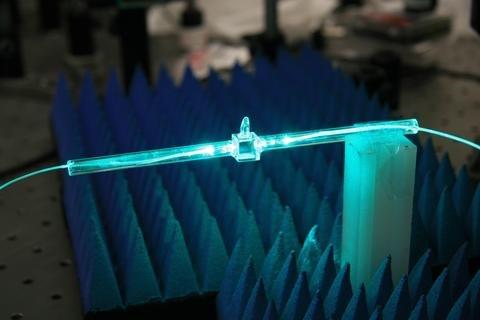Electric Field Metrology
The Technology

New NIST prototypes employ a fundamentally new approach for measuring high-frequency electric fields. The devices take advantage of the properties of Rydberg atoms, whose outermost electrons are in very high orbits around the atomic nucleus. Very sensitive to electric fields, Rydberg atoms can measure fields both far away and nearby. The prototypes are now smaller than a sugar cube, with the potential to shrink even more.
In the prototype, two laser beams of different wavelengths intersect in a vapor cell containing Rydberg atoms of an element such as cesium. Because of quantum-mechanical effects, the atoms become transparent to the first (“probe”) beam. But when an electric field from a radiofrequency (RF) wave is applied to the atoms, the field changes the spectrum of the probe beam — an effect that is easily measured and is directly proportional to the applied electric field.
Very precise E-field measurements are possible by placing atoms of two different elements in the vapor cell. Because each element responds to an identical electric field in its own distinctive way, comparing the two can dramatically reduce measurement uncertainties.
Recently, NIST researchers developed a technique to measure the phase of the electric field and demonstrated the ability to detect phase-modulated signals that are typically used in communications systems. The technique allows for the full characterization of an electric field and modulated signals in one compact sensor — that is, it can measure multiple properties of the field including amplitude, phase and polarization.
These devices can currently detect E-field strength down to approximately 46 µV/m ± 2 µV/m, which represents both higher sensitivity (about 100 times greater) and lower uncertainty (about 4%) than existing commercial instruments. This technology can potentially perform traceable calibrations of electric fields from RF waves with frequencies above 110 GHz, a capability that is currently not available.
Advantages Over Existing Methods
Conventional E-field probes have traditionally been hampered by a chicken-and-egg dilemma: To calibrate the probe, you need a reference electric field whose values are accurately known. But to have a known field, you need a calibrated probe. This need for calibration limits accuracy and increases errors.
Even the best commercial instruments produce measurements with uncertainties that are at least 10% of the measured value. Uncertainties of that magnitude are much too large for the exacting needs of many critical future applications in industry and science.
In contrast, the NIST prototypes have much lower uncertainties, on the order of 4%. They can sense electric fields a hundred times weaker than conventional devices can. And unlike traditional probes, they can measure frequencies in the hundreds of gigahertz range that is so important for modern applications.
Applications
Next-generation wireless communications and radar systems will operate at ultra-high electromagnetic frequencies and require accurate recognition and amplification of very brief signals. Accurate measurement of electrical fields can lead to technological advances in these systems.
Key Papers
C.L. Holloway, M.T. Simons, A.H. Haddab, J.A. Gordon, D.R. Novotny. Embedding a Rydberg Atom-Based Sensor into an Antenna for Phase and Amplitude Detection of Radio Frequency Fields and Modulated Signals. IEEE Access Journal. Oct. 22, 2019. DOI: 10.1109/ACCESS.2019.2949017
M.T. Simons, A.H. Haddab, J.A. Gordon, C.L. Holloway. Applications with a Rydberg Atom-based Radio Frequency Antenna/Receiver. Proceedings of the IEEE International Conference on Electromagnetic Compatibility. Sept. 2, 2019. DOI: 10.1109/EMCEurope.2019.8872108
J.A. Gordon, C.L. Holloway, M.T. Simons, A.H. Haddab. Weak Electric-Field Detection with Sub-1 Hz Resolution at Radio Frequencies Using A Rydberg Atom-Based Mixer. Applied Physics Letters. April 25, 2019. DOI: 10.1063/1.5095633
C.L. Holloway, M.T. Simons, A.H. Haddab, J.A. Gordon. A Rydberg Atom-Based Mixer: Measuring the Phase of a Radio Frequency Wave. Applied Physics Letters. March 18, 2019. DOI: 10.1063/1.5088821
M.T. Simons, M.D. Kautz, A.H. Haddab, J.A. Gordon, C.L. Holloway, T.P. Crowley. Rydberg Atom-based RF Power Measurements. 2018 Antenna Measurement Techniques Association Symposium (AMTA). Nov. 4, 2018.
Key Patents
D.A. Anderson et al. Atom-based electromagnetic radiation electric-field sensor. WIPO (PCT) Application WO2016205330A1. Filed June 15, 2016.
Contacts
-
(303) 497-6184

